WordPress (WP) is a widely used content management system (CMS). The number of WordPress users is growing every day. According to data on the internet, 62.8% of websites created with a known CMS are powered by WordPress. That's 43.2% of all websites! It's impressive, isn't it?
In this article, we take a look back at the history of WordPress software and how it all began. We'll also trace when plugins and themes emerged and how they evolved to make WordPress the platform we know today.
But before we embark on a journey into the past, let's answer the question: What is WordPress anyway?
What Is WordPress?
WordPress is an open-source content management system with a GPLv2 license, which means that it can be used or modified by anyone free of charge.
WordPress is built in PHP (short for Hypertext Preprocessor) in combination with MySQL (Oracle's relational database management system) or MariaDB with HTTPS support. The functions include WordPress themes and plugins.
Virtually anyone can use WordPress without having any programming knowledge. WordPress also allows you to choose a domain and hosting, and if you opt for shared hosting with cPanel, you can install WordPress directly from there. If this is difficult for you, you can always contact the hosting company's technical support.
Check out our list of the best SEO plugins for WordPress you can start using today.
WordPress History: Before It All Began
In 2000, at the beginning of the 21st century, 30-year-old self-taught webmaster Michel Valdrighi joined an association dedicated to the preservation of the Corsican language. To this end, he needed a suitable platform to create a dictionary.

Since Michel Valdrighi already had a blog on Blogger, he was looking for a better solution, so he created his first project with PHP and MySQL, Blogger 2. A year later, in 2001, b2/cafelog appeared, an open-source software for publishing blogs written in PHP and combined with a database (MySQL). The abbreviation b2 comes from Blog 2.
10 years later, at WordCamp Paris 2011, he revealed that b2 came about as a result of his desire to create his own Blogger and was inspired by "listening to Blur's song 2."
His project has been successfully launched, and there is no shortage of enthusiasts. Among them is Matt Mullenweg, a young American saxophonist nicknamed "saxmatt."
May 2003: Valdrighi Retires, but "Saxmatt" Takes Over the Baton
A few months later, Valdrighi withdrew and abandoned his b2/cafelog project. The disappointment for Mullenweg is great, but his enthusiasm is even greater. He did not give up and decided to fork b2—to create new software from the source code of b2.
Mullenweg put his plan into action, and WordPress officially launched on May 27, 2003, with version 0.7. So, May 27 is considered the official birthday of WordPress, and in 2024, we will celebrate 21 years since the platform's official start.
Mullenweg says: "WordPress was born out of a desire to have an elegant, well-designed publishing system built with PHP and MySQL and licensed under the GPL."
Two co-founders are behind this CMS that will go down in history:
- Matt Mullenweg, also known as "saxmatt"
- Mike Little, a British developer.
The first version of WordPress (WordPress 0.7) is minimalist. Here's what it contains, according to the official WodPress.org website:
- A texturing engine
- Link manager
- XHTML 1.1 compliant templates
- A new administration interface
- The ability to create manual extracts and new templates
And here, you can see what the first WordPress version 1.0 looked like back then:
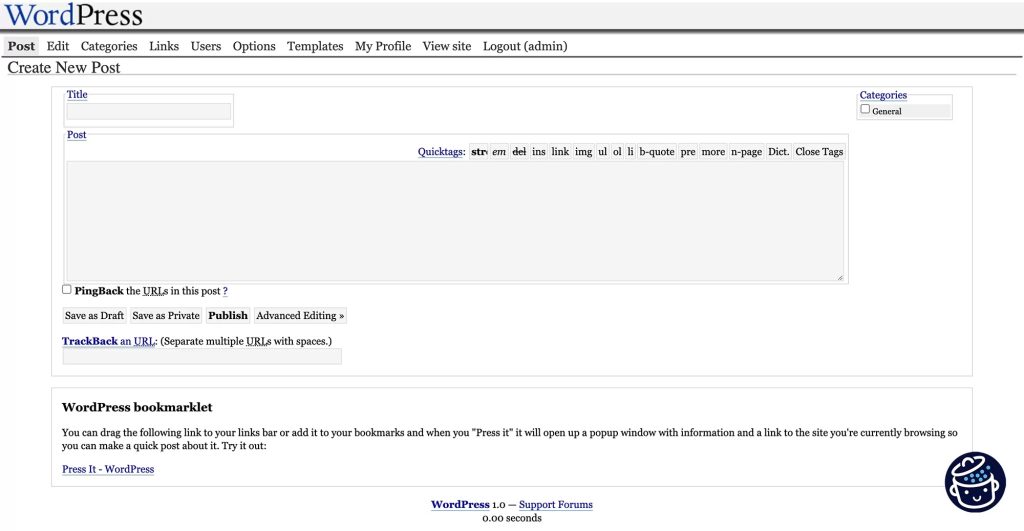
Currently, b2 continues to exist under the name b2evolution, but all traces in WordPress filenames were deleted in December 2003, with "wp-" replaced by "b2".
The creator of b2, Michel Valdrighi, supported WordPress until 2005 to ensure continuity between the two tools.
What is the Origin of the Name WordPress?
For b2, we've already indicated that it's a reference to Blogger and a song by the British rock band Blur, but let's take a look at where the name WordPress comes from Its author is Christine Tremoulet, a friend of Matt Mullenweg.
She said that Mullenweg wanted the name of the platform to make a connection to print media or printing in general. He wanted to create an analogy to Gutenberg's revolutionary invention in the 15th century, the founder of modern letterpress printing.
He wanted to make an analogy with Gutenberg's revolutionary invention in the 15th century, the founder of modern letterpress printing. Thus begins a play on words: Type press + blogging = WordPress (or "Word Press" if you want to spell it correctly). WordPress was conceived as an analogy to print media to allow bloggers to write about topics that are important to them.
January 2004: Launch of WordPress 1.0
The official version 1.0 of WordPress started on January 3, 2004, and was named Davis (Miles Davis). This will hardly surprise you, as Mullenweg has a great passion for jazz.
WordPress 1.0 includes the following features:
- Permalinks: a system of URLs that can be indexed by search engines as well as rewritten
- Multi-category support
- A more advanced update process
- In-browser installation
- The ability to migrate a website created with another tool (Blogger, Movable Type, Textpattern, b2, etc.) using a script
Here is what the interface used to look like:
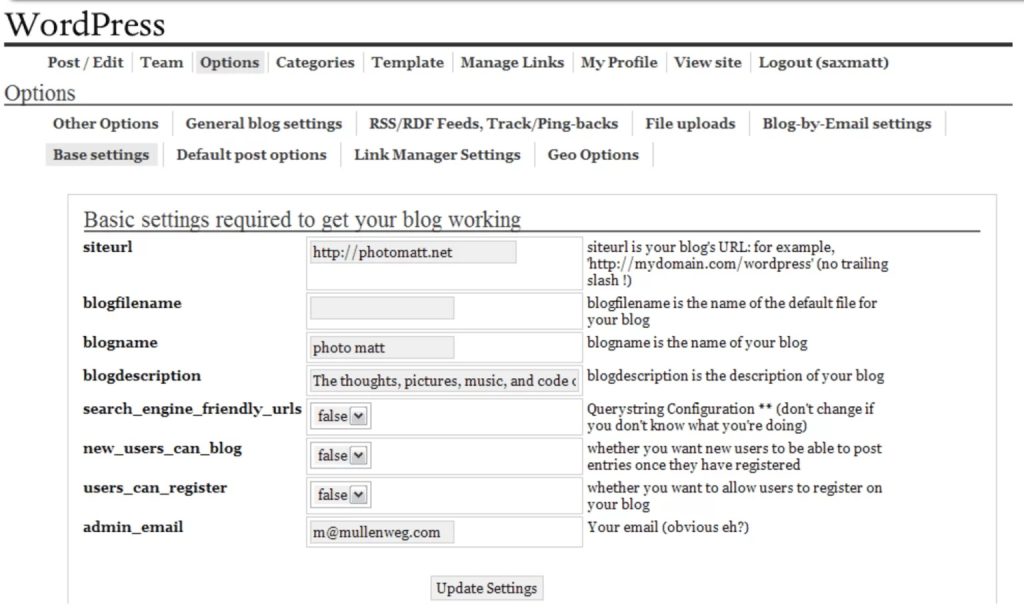
May 2004: The First WordPress Plugins and Hello Dolly
Version 1.2 of Mingus was released on May 22, 2004. This introduced plugins, which make it possible to add functions to the WordPress core without changing the code. There are currently over 60,000 plugins in the official directory.
The first plugin is Hello Dolly. It was developed by Matt Mullenweg and is still supported (it is added to every WordPress installation), but has no practical use and is more for fun. The plugin displays random lyrics from Louis Armstrong's song “Hello Dolly” in the top right corner of the WordPress admin panel.
I and many others uninstall it as soon as we start working on a WordPress site, but I always think of this story and how it all started—a tribute to the creators of WordPress.
Other new features in this version of WordPress are:
- Automatic creation of thumbnails and image thumbnails.
- Password encryption to improve security.
- Maintaining category hierarchy.
- Advanced comment moderation.
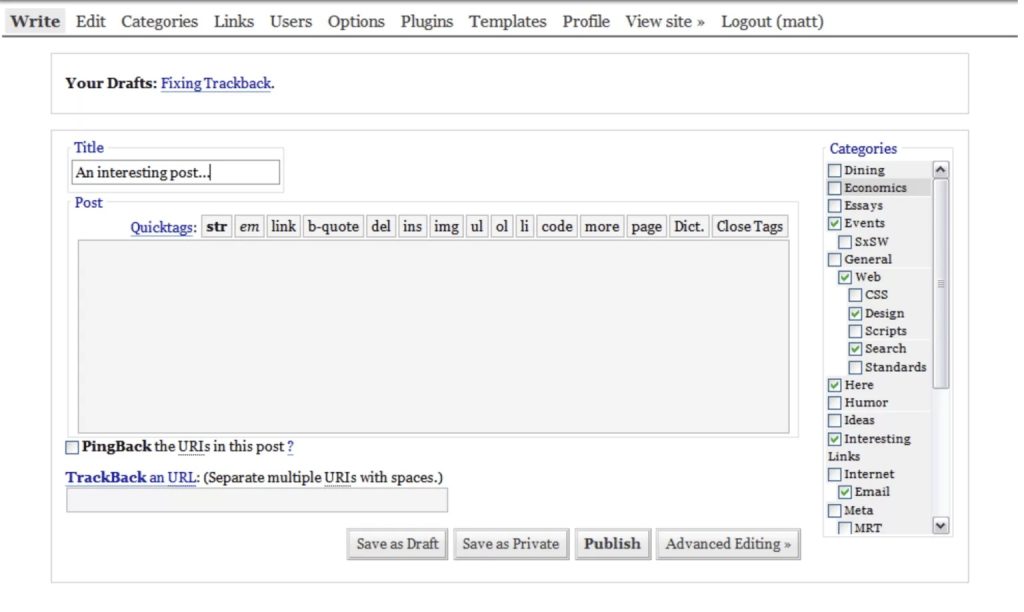
February 2005: Themes, Static Pages, and a Plugin Directory
With WordPress 1.5 (Strayhorn), themes and the option for static pages appeared, turning WordPress into a fully-fledged content management system (CMS).
Read our article to learn more about the difference between static and dynamic sites.The first standard theme is called Kubrick. Another important new feature is the creation of a plugin directory where developers and WordPress users can lend a hand.
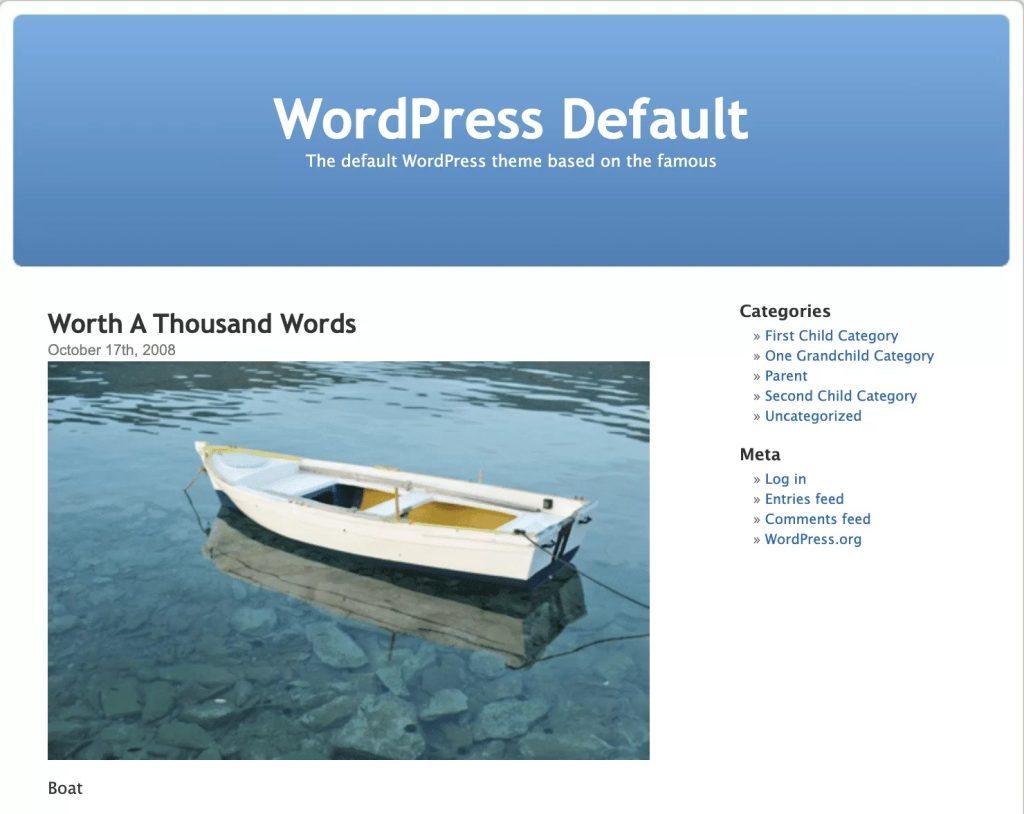
December 2005: The Visual Editor (WYSIWYG) is Launched
WordPress 2.0 was released under the name "Duke" and established the platform as a tool for creating and maintaining WordPress blogs. The visual editor TinyMCE was integrated into WP Core after several months of development.
The visual editor in WordPress was developed by the TinyMCE team and developer Andy Skelton. It is open source and enables online editing of text with the option of seeing changes in real time (WYSIWYG, What You See Is What You Get).
With the ability to upload images, videos, and files, the visual editor is a revolution in content creation.
Also added were permanent caching and a new role system for users. In addition, the Akismet plugin appeared, which has since been installed by default in WordPress to combat spam and unwanted comments.
2007, 2008, and 2009: WordPress Theme Directory
No new major version was implemented in 2006, but in the following two years, 2007 and 2008, six major updates were made, namely:
- Ella (WordPress 2.1) is named after jazz singer Ella Fitzgerald and introduces a new user interface, automatic saving, automatic correction, and other functions.
- Getz (WordPress 2.2) is named after saxophonist Stan Getz and introduces widgets.
- Dexter (WordPress 2.3) is named after saxophonist Dexter Gordon and introduces a new taxonomy system and update notifications so that we can see in the administration area that a new version is available.
- Brecker (WordPress 2.5), named after jazz musician Michael Brecker, introduces a new WordPress admin interface, the widget system, and a short code API.
- Tyner (WordPress 2.6) bears the name of jazz pianist McCoy Tyner and makes it possible to track changes to pages and posts.
- Coltrane (WordPress 2.7) is named after saxophonist John Coltrane, and comes with a redesigned admin panel, and introduces automatic updates.
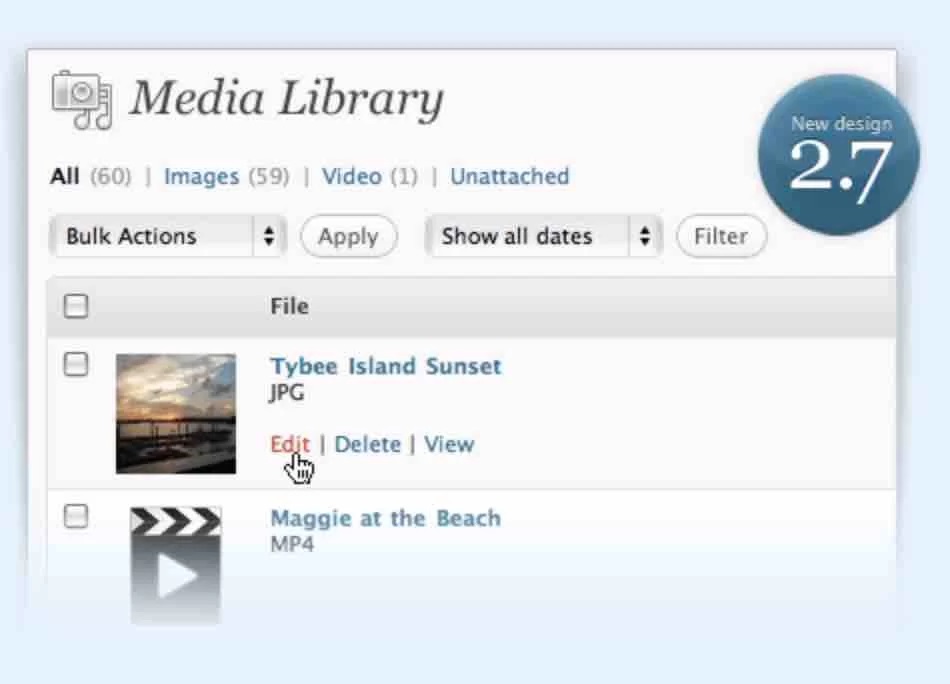
The theme directory was introduced in 2008 and now contains over 10,000 entries. The implementation of this function took almost 5 years and, together with the plugin directory, is still one of the most used.
In 2009, two versions of WordPress were introduced:
- Baker (WordPress 2.8) is named after the famous trumpeter and singer Chet Baker. It includes an integrated theme installer and offers WP speed optimization.
- Carmen (WordPress 2.9) is named after American jazz singer Carmen Mercedes McRae. It enables group WordPress plugin updates and supports oEmbed, a format that allows you to integrate content from social networks by copying a link from a post.
June 2010: Different Types of Publications
In June 2010, a new and very extensive update of WordPress—Thelonius (WordPress 3.0)—was implemented—the 13th in a row, with 218 developers involved in its development. It is named after the jazz composer and pianist Thelonious Sphere Monk and introduces different types of posts to be able to create content other than posts and pages.
The ability to manage multiple websites is also provided by the integration of WordPress MU into WordPress Core. WordPress multi-user allows you to create networks of blogs with a common interface.
A new default theme called Twenty Ten has also been added. Here is a view of it:
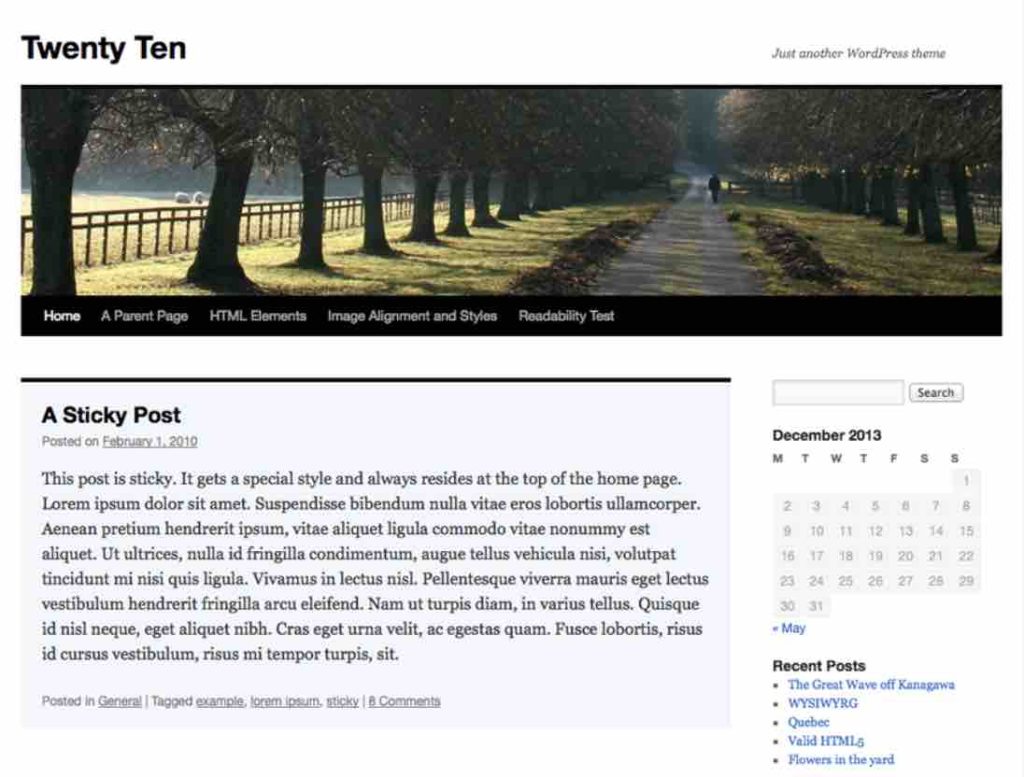
2011: Admin Bar and Default Twenty-Eleven Theme
In 2011, WordPress released three main versions, including:
- Reinhardt (WordPress 3.1) is named after jazz guitarist Django Reinhardt and introduces an administration bar to make it easier to manage the website. The various menus are located in it.
- Gershwin (WordPress 3.2) is named after famous composer and pianist George Gershwin and includes a new default theme (Twenty Eleven), improves the administration bar, and "makes WordPress a faster and easier CMS."
- Sonny (WordPress 3.3) is named after jazz saxophonist Sonny Stitt and improves the user experience for beginners, for example, by the appearance of "welcome messages and functional tips."
2012–2017: Customization Tool, Media Management and Automatic Updates
In the years that followed, WordPress was improving at a rapid pace, with two to four major updates per year. Here are some of the most important changes:
- Customization tool or a theme customizer to apply changes in real time (WordPress 3.4 "Green").
- Media management with WordPress 3.5 "Elvin."
- Automatic maintenance updates and security updates with WordPress 3.7 "Basie."
- Redesign of the WordPress dashboard "with a more modern design and new vector icons" with WordPress 3.8 "Parker." This design from December 2013 is still up to date more than ten years later.
- Drag and drop features for images and a theme browser in WordPress 3.9.
- Plugin recommendations and easy language switching are the main novelties in WordPress 4.1 "Dinah."
- Enhanced mobile experience and better password security with WordPress 4.3 "Billie."
- Inline linking and live responsive previews are highlights of WordPress 4.5 "Coleman."
- Added oEmbed support for WordPress posts with an extended preview. Successful integration with the WordPress REST API for communication with other websites and applications (WordPress 4.4 "Clifford").
- PDF preview and video header support are among the most interesting features of WordPress 4.7 "Vaughan."
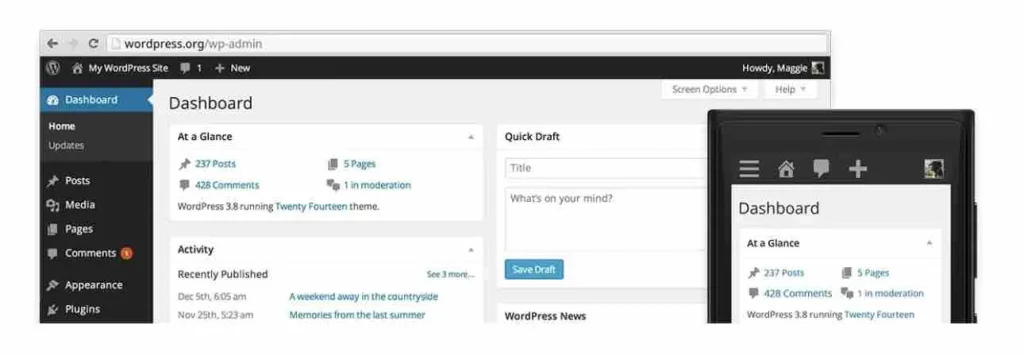
2018: WordPress Is No Longer Just a Blogging Platform, but a Real CMS—the Gutenberg Revolution
In 2018, a revolutionary new content editor called Gutenberg was introduced to transform WordPress from a blogging tool into a content management system.
The content editor is named after Johannes Gutenberg, the inventor of letterpress printing in the 15th century. The new content editor is integrated into WordPress 5.0 under the name "Bebo."
The Gutenberg editor replaces the TinyMCE editor, which was introduced 13 years earlier, in 2005. Gutenberg was met with much criticism and apprehension but emphasized the need for blocks—containers in which content (text, images, videos, audio, etc.) can be inserted into posts and pages.
The introduction of the new editor, Gutenberg, aims to position WordPress as an open-source alternative to competitors such as Wix or Squarespace. Subsequent versions will focus on improving the editor's performance, adding new features (layouts and styles), and introducing new blocks.
2020: Automatic Updates for WordPress Themes and Plugins
With WordPress 5.5, "Eckstine" integrates a directory of Gutenberg blocks directly into the editor. This version also brings other improvements for websites:
- Speed — with delayed loading of images.
- Search — with the inclusion of a standard XML sitemap.
- Security — with the option to activate automatic updates for plugins and themes.
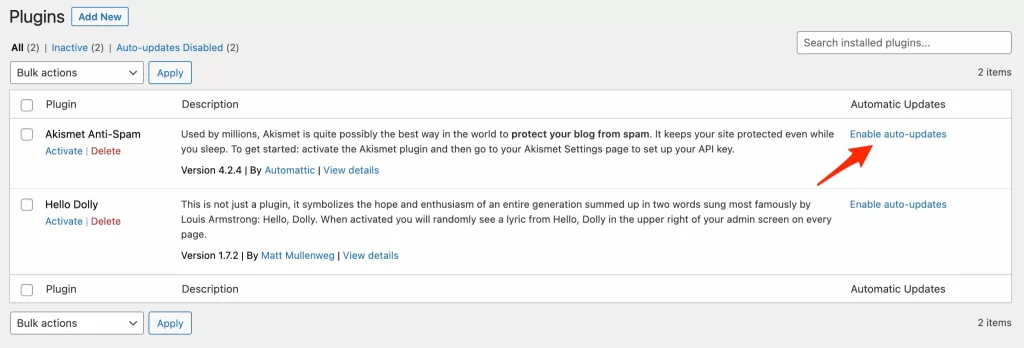
This version has the most contributors so far: 805 people. In 2020, a new version was implemented for the first time by a 100% female WordPress team: WordPress 5.6 "Simone," led by Josepha Haden Chomphosy, the current CEO of WP.
WordPress Core's automatic updates have been extended to new installations, and a new theme has been developed: Twenty Twenty-One.

2021: HTTPS and Widget Management Using Blocks
In 2021, the pace of implementing new updates slows down—from 3–4 to "only" two. WordPress 5.7 "Esperanza" improves the content editor and introduces the ability to switch from HTTP to HTTPS with one click.
WordPress version 5.8 "Tatum" was introduced in July 2021 with an important change: the management of widgets using blocks. This highlights the evident development of managed WordPress hosting solutions. What’s more, WordPress started supporting the WebP format to reduce the weight of images and improve page loading speed.
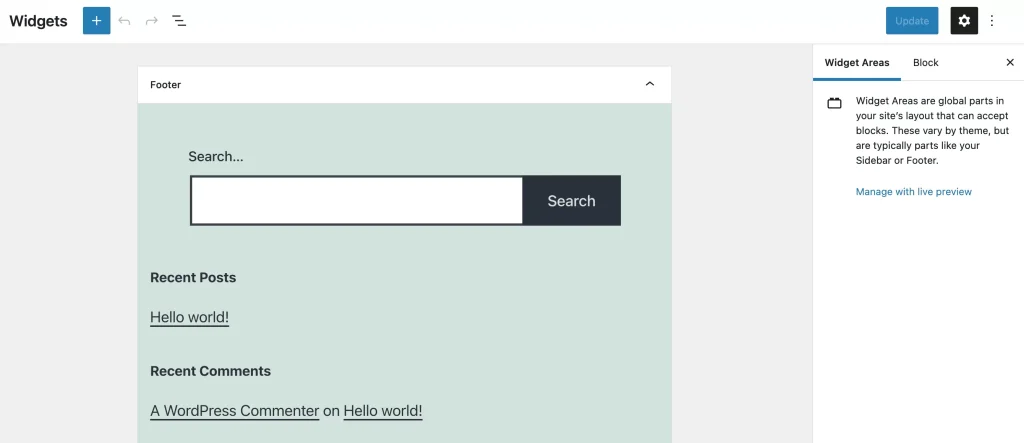
2022: Full Site Edit
The next revolutionary change after the introduction of Gutenberg in 2018 was the release of WordPress 5.9 "Josephine" with the implementation of Full Site Editing (FSE). With the content editor blocks, you can edit the entire structure of your website (including headers, footers, menus, and page templates, as well as content).
Full Site Editing brings WordPress into proximity with website builders such as Elementor Pro or Divi Builder, as well as closed-platform solutions like Wix, Shopify, or Squarespace.
To take advantage of Full Site Editing (FSE), you need to activate a compatible theme and have the necessary knowledge to work with it.
Don’t know where to start? Check out our article on how to make a WordPress blog.
Important Dates and Milestones in the History of WordPress
Let's follow the most important dates and events in the history of WordPress versions and the development of their ecosystem:
2005: Launch of Automattic
The company that has contributed the most to the development of WordPress, like Matt Mullenweg, is Automattic. It was founded in San Francisco in 2005 when Mullenweg was 21 years old, and today it employs almost 2,000 people in over 100 countries around the world.
Automattic is a play on Matt's first name. This company is behind the WordPress.com hosting platform and, of course, the WordPress.org software.
WordPress.com isn't the only site Automattic owns. Other examples include:
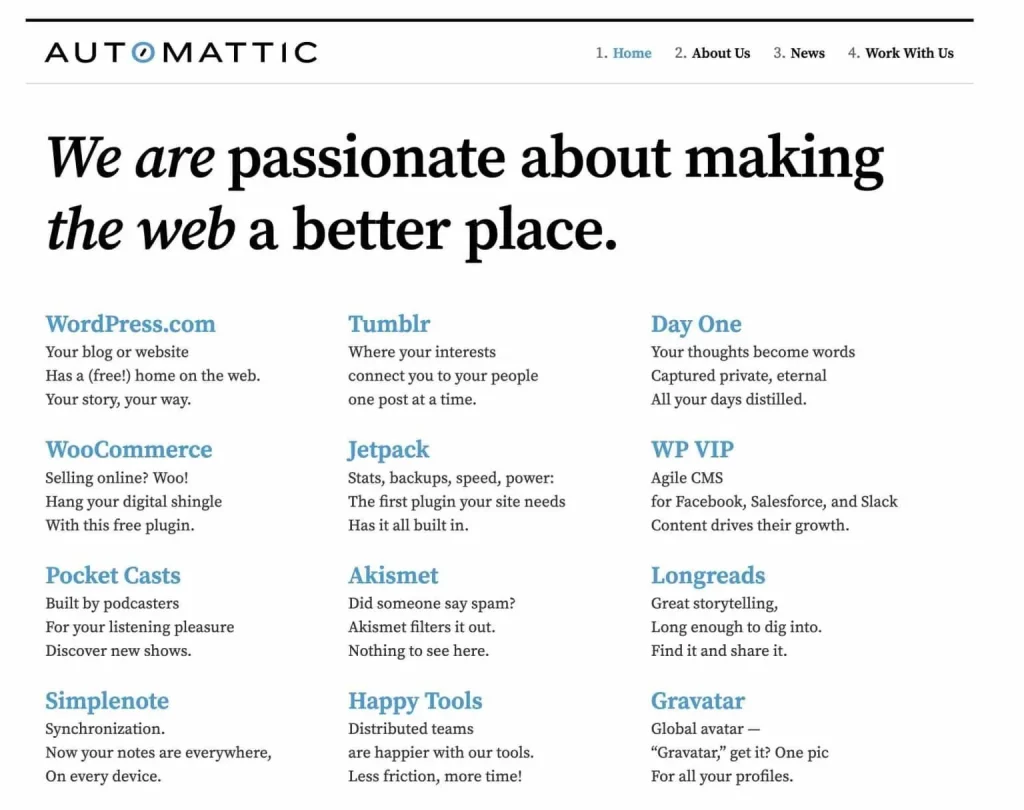
In addition to WordPress.com, Automattic also owns:
- Akismet
- Jetpack
- WooCommerce
- Tumblr
- Gravatar
- SimpleNote
- DayOne, etc.
2006: the First WordCamp in the History of WordPress
WordCamp is an event organized by the local WordPress community that brings fans, enthusiasts, and contributors together in one place.
August 2006 marked the first WordCamp organized by Matt Mullenweg in San Francisco. In his WordPress blog, he defines the WordCamp concept as follows: "A one-day free BarCamp-style conference with a party in the evening. There will be a free barbecue lunch, WordPress t-shirts, and a full day of discussions between users and developers."
Over time, WordCamp events have become more and more sophisticated, and a small participation fee is charged to cover the costs of the organization.
Since the beginning in 2006, there have been over 1100 WordCamp events on 6 continents, in 65 countries, and in 375 different cities. WordCamp Europe takes place in a different city each year, as does WordCamp US.Due to the pandemic, there have been no live events here in recent years, but in 2023, the first event in Bulgaria—WordCamp Sofia 2023—took place on April 22. You can buy a ticket or register as a speaker now.
2007: Acquisition of Gravatar by Automattic
A year later, in October 2007, Automattic made one of its most important acquisitions: Gravatar, a free service launched in 2005 that allows users to manage their avatars on the Internet.
If you have a WordPress account, you should first upload your profile picture to Gravatar to select it.
2009: WP Tavern launched
WP Tavern is the most-read source for CMS news. It reports on news and events, writes plugins and theme reviews, and discusses everything related to WordPress.
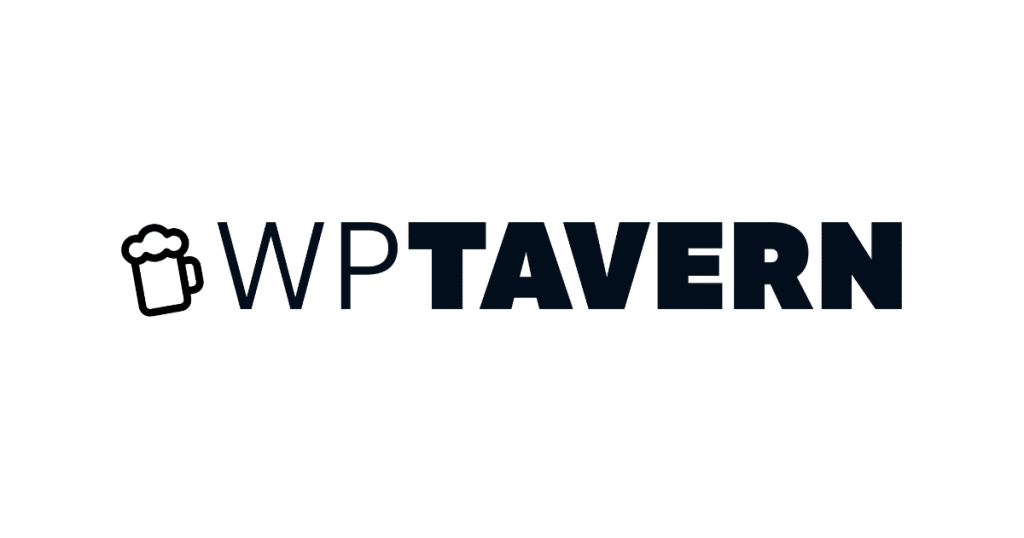
WP Tavern was founded in January 2009 by Jeff Chandler and taken over by Audrey in June 2011, again with Matt Mullenweg in the background.
2010: The WordPress Foundation took over the WordPress brand
In 2010, Mullenweg founded the WordPress Foundation, a non-profit organization, to "guarantee free access to the software projects we support forever."
To protect the WordPress trademark and logo, Automattic transferred ownership of them to the foundation.
2014: The “Five for the future” WordPress project started
It was announced in 2014 that Automattic would devote 5% of its time to the development of WordPress Core. Mullenweg is calling on all interested companies and individuals to do the same and join "The Five for the Future" project. Currently, the number of participants is many times greater.
2015: Automattic acquired WooThemes and WooCommerce
2015 was a pivotal year in WordPress history, with one of the most important acquisitions since Automattic was founded (2005), namely that of the South African company WooThemes. An adaptation of the WooCommerce plugin enables WordPress websites to be converted into online stores.
This means that the WordPress platform is not only for creating websites but also online stores, and the aim, according to Matt Mullenweg, is to "make it easier for people to sell online."
WooCommerce has over 5 million active installs and is the most popular e-commerce plugin in the WordPress ecosystem. It is used in over 9 out of 10 WP online stores. Worldwide, it is also the most popular tool for e-commerce websites.
Get started setting up your online store with the help of our WooCommerce tutorial.
2019: Tumblr acquisition
The acquisition of Tumblr (the microblogging platform) in summer 2019 is another important step for Automattic and WordPress, both from a business perspective and in terms of employees (200) and users (475 million blogs).
2021: Acquisitions increase
The development of the WordPress ecosystem has been accompanied by takeovers, mergers, and other acquisitions, some of which have been large-scale and others more private. In this respect, 2021 is an exceptional year with 45 acquisitions.
Here are the major players that have become a part of the WordPress ecosystem:
- The US hosting giant GoDaddy acquired Pagely, a popular hosting provider specializing in WordPress.
- Awesome Motive, a company owned by Syed Balkhi (WPBeginner), acquired Easy Digital Downloads and all plugins developed by the same company (Sandhills Development): AffiliateWP, Sugar Calendar, WP Simple Pay and Payouts Service.
- Newfold Digital acquired Yoast SEO.
- Automattic acquired Parse.ly, a web analytics and content optimization platform.
The Future of WordPress: What's Next?
Although WordPress started as a blogging platform, it’s now the world's most widely used tool for creating websites. 43.1% of the most visited websites are created with WordPress. Compared to WordPress, its competitors hold a market share of less than 5%: Shopify (4.3%), Wix (2.3%), Squarespace (2%), Joomla (1.7%), and Drupal (1.2%).
WordPress' market share has grown in recent years, but its growth slowed slightly in the first half of 2022. WordPress lost 0.3% of its market share between March and April 2022. Whether this is an isolated event or a trend is something we will be monitoring over the coming months.
However, WordPress will certainly not be ousted from its position as the number one CMS for many years to come. WordPress' main competitors are self-hosted SaaS solutions such as Shopify, Wix, and Squarespace, similar to Joomla and Drupal.
Another major threat to WordPress is Elementor. The most popular website builder in the WordPress ecosystem is growing exponentially and is used by over 7% of the most visited websites.

Although Elementor requires WordPress to function, it now offers its own cloud-based hosting service to approximate the WordPress.com model. It may decouple from the WordPress system in the future.
More cooperation and more languages
WordPress developers aim to make the platform "software for everyone," focusing on accessibility, performance, security, and ease of use."
The plan for the future is to focus most of the contributors' efforts on Gutenberg. Initially, improvements and changes are planned for the FSE project, which is still at an early stage.

Gutenberg is currently in Phase 3 of its long-term roadmap. The focus is on collaboration and providing more intuitive features for collaborative content creation.
The WordPress core will be updated to support multilingualism during Phase 4. The best is yet to come!


